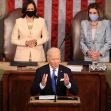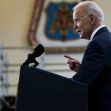President Biden visited a Philadelphia Amtrak station over the weekend in his most recent push to promote his administration’s infrastructure plan. Within the American Jobs Plan, President Biden is proposing $621 billion of the total $2 trillion to go toward transportation and infrastructure to focus on electric vehicle sales, rail projects, public transit, modernizing roads, and reconnecting neighborhoods cut off by historic highway projects.
The American Jobs Plan proposes $80 billion for rail projects, including addressing Amtrak’s repair backlog. The Biden administration wants to improve Amtrak’s high-traffic corridors, such as from Washington to Boston, and expand service to 160 communities. Bill Flynn, the CEO of Amtrak lauded the plan and noted that some of the tunnels and bridges “are over a century old.”
Outside of the focus on Amtrak, the plan leaves open the possibility for using some of the funds to invest in high-speed rail projects. The plan also calls for $85 billion to improve public transit, including replacing thousands of buses and rail cars and repairing hundreds of public transit stations.
Another large portion of the $2 trillion proposal will focus on improving roads, bridges, and overall road safety. The Administration proposes $115 billion to modernize 20,000 miles of highways, roads, and main streets; fix ten of the most economically significant bridges in the country; and repair the worst 10,000 of the country’s smaller bridges. Another $20 billion will go toward improving road safety, which the Administration states is the cause of more than 35,000 deaths each year. Additionally, $20 billion would be used to reconnect urban neighborhoods cut off by historic highway projects.
The Biden Administration also wants to increase the U.S. share in the electric vehicle global market which is one-third of China’s market share. The Administration is also calling on Congress to create a point-of-sale rebate and tax incentives to buy American-made electric vehicles. The plan also looks to install 500,000 charging stations for electric vehicles by 2030 through grant and incentive programs for state and local governments and the private sector.
Through the Clean Buses for Kids Program at the Environmental Protection Agency, the proposal seeks to electrify at least 20% of the yellow school bus fleet throughout the country. In the 2018-2019 School year there were 479,867 public school buses in operation throughout the country with a total annual mileage of over three billion miles. Daily, roughly 21 million students are transported to public schools using a school bus, equating to 57 percent of the total students enrolled in K -12 public schools.
“To position the U.S. as a leader in clean freight and aviation,” the Biden administration wants to spend $25 billion on airports, which will include funding the Airport Improvement Project and upgrading FAA assets. The project will renovate terminals and create connections for “affordable, convenient, car-free access to air travel.”
Another $17 billion is earmarked in the plan to improve waterways and ports of entry to improve the infrastructure that is essential to the nation’s freight industry and to “mitigate the cumulative impacts of air pollution on neighborhoods near ports.”
The Biden administration’s reasoning behind promoting this project is to combat climate change and create jobs for the American public. President Biden stated that 90 percent of those jobs would not require a college degree. The Administration sees this as an opportunity to connect big cities and employment opportunities to underserved communities and to “invest in America in a way we have not invested since we built the interstate highways and won the Space Race.”
To pay for the plan, President Biden is simultaneously promoting the American Tax Plan which will raise the $2 trillion needed for the infrastructure over the next 15 years. According to the Administration’s factsheet on the proposal, in 2018, 91 Fortune 500 companies paid $0 in federal taxes on U.S. income. This plan raises corporate tax rates from 21 percent to 28 percent and eliminates rules that allow U.S. companies to pay reduced or no taxes on foreign investments and ensure corporations pay their “fair share in taxes and encourage job creation at home.” The current Administration blames a Trump-era tax law that allows companies to evade paying minimum taxes for U.S. multinational corporations through utilizing tax-havens.
Opposition to the plan has largely centered around the amount of the proposed spending and the raise to corporate tax rates. Republican Ohio Senator Rob Portman indicated “there’s a way forward” to negotiate the plan but criticized the plan saying only 20 percent of the spending is actually going toward traditional infrastructure spending. Portman also disagrees with the hike in corporate tax rates and favors public-private partnerships instead.






